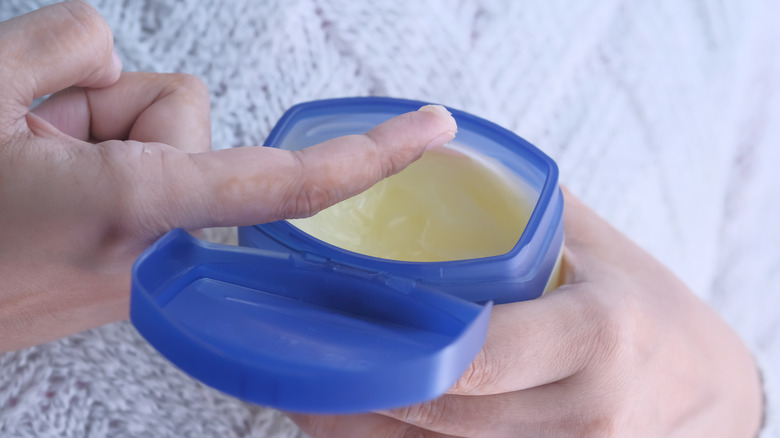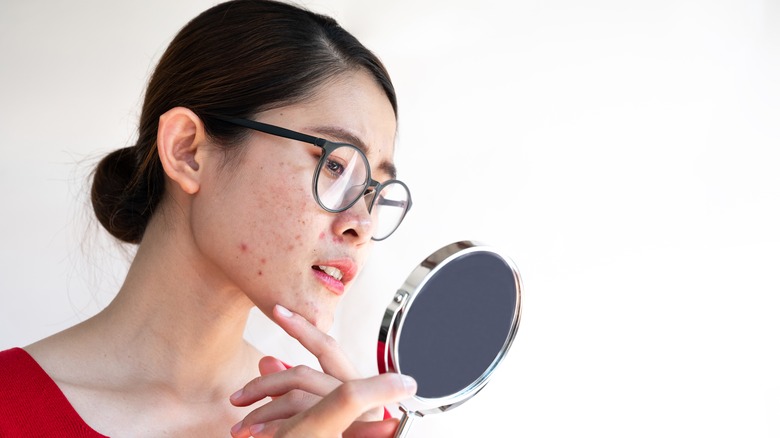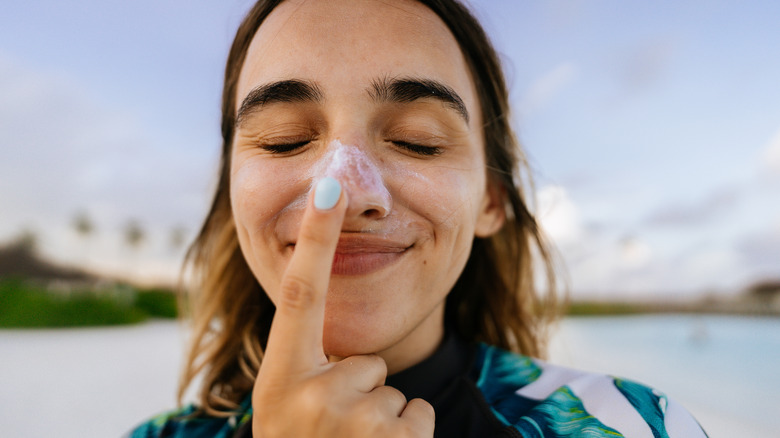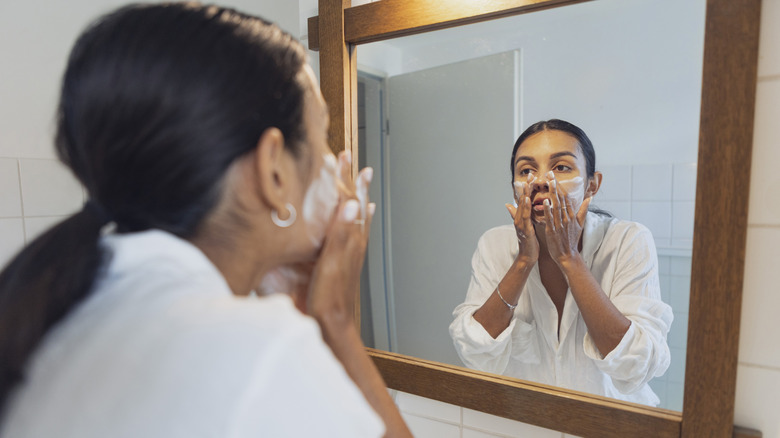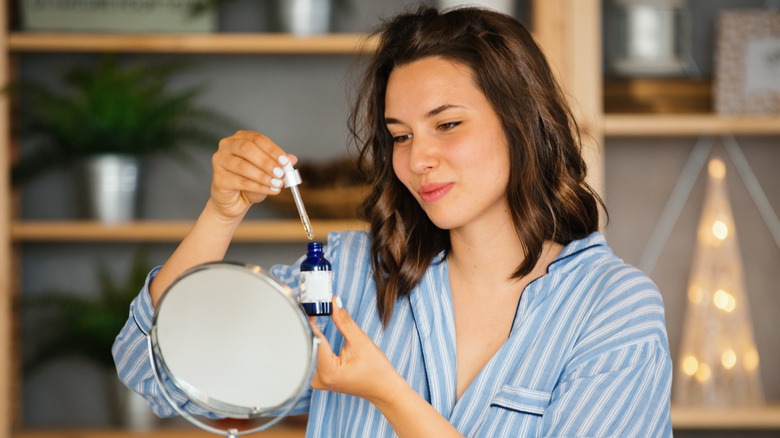Signs You May Want To Avoid Vaseline In Your Skincare Routine
Vaseline is no longer just your mother's skin savior — thanks to trends like slugging, the old first-aid standby is now being incorporated into beauty routines everywhere. Vaseline, a brand name for petroleum jelly, acts as a seal on the skin. According to Healthline, the semi-solid jelly is perfect for locking in moisture and protecting dry and cracked skin.
Slugging took this idea and ran with it. Essentially, slugging involves slathering Vaseline all over the face to achieve a glowy, hyper-hydrated, glazed donut complexion. Some skincare junkies swear by the hack and make sure to slug every night before bed, and others even suggest daytime slugging to keep skin and makeup looking fresh for hours.
Even if Vaseline has developed a cult following of SkinTokkers and beauty lovers, the humble product doesn't belong in everyone's skincare routine. Get to know the signs that your skin might be better off without petroleum jelly, like if you tend to spend a lot of time under the sun or are susceptible to acne.
You have acne or skin congestion
Whether you intend to slug your entire face or dab just a little Vaseline on a few dry patches, you might want to rethink your plan if you're prone to breakouts or clogged pores. The American Academy of Dermatology Association warns that petroleum jelly might cause breakouts for those who struggle with acne. Dr. Sheilagh Maguiness, a board-certified dermatologist and co-founder of the acne skincare line Stryke Club, echoed this, telling Elle, "Individuals with active acne breakouts or blackheads should probably avoid [slugging] and opt instead for treatment with ingredients aimed at fighting acne, such as salicylic acid, benzoyl peroxide, and topical retinoids."
Despite these warnings, you might hear others claim that petroleum jelly doesn't trigger acne. The Vaseline website, for example, says the product won't clog pores and is safe for acne-prone skin. If you're still keen to add Vaseline to your skincare routine, especially if you want to slather it all over, at least be sure to proceed with caution. "I recommend a test spot before slugging the entire face for acne-prone skin," board-certified dermatologist Dr. Elyse Love shared with InStyle.
You have a sunburn or spend a lot of time in the sun
You may have heard at one point or another that Vaseline can help soothe sunburns. However, if you have a fresh sunburn or tend to forget to apply SPF, which, friendly reminder, is a bad habit that should be broken ASAP, it's best to skip the jelly solution altogether.
First, to clear up Vaseline's purported sunburn-healing properties: Vaseline can indeed relieve burns, according to Healthline, but only once they've already started healing. Until then, the product could make your sunburn even worse by locking in heat. As dermatologist Dr. Marisa Garshick told Insider, it's a good idea to wait at least 24 hours after the burn starts before using Vaseline.
Some experts also believe that petroleum jelly formulas could exacerbate sun damage. "[P]roducts with petroleum like Aquaphor or Vaseline put you at risk for a sunburn, as they do not have photoprotection or SPF," Dr. Elizabeth Bahar Houshmand, a fellow at the American Academy of Dermatology, explained to Buzzfeed News, comparing the effects to "applying baby oil to the skin and getting a sunburn." Wearing sun protection can mitigate some of the risk, though keep in mind that your slugged skin might feel extra slimy when both sunblock and Vaseline are layered together. If the combination feels too oily, nix the Vaseline and keep the SPF.
You're not a fan of double cleansing
Those who are happily slugging along on the Vaseline bandwagon love that the jelly seals in moisture, but hydration isn't the only thing being locked into the skin — dirt and makeup can also become trapped under your thick layer of sticky Vaseline, as per Healthline. Therefore, if you're not interested in double cleansing (devoting two steps to washing away makeup and other grime), or if you're guilty of sometimes going to bed with a little foundation left over, you may want to avoid Vaseline in your skincare line-up.
Dr. Karishma Kagodu, a cosmetic plastic surgeon and founder of Dr. Karishma Aesthetics, explained to Vogue India, "For optimal results, apply [Vaseline] as a pre-bed routine after using a gentle face wash. It is important to take away all that extra sebum, [and] makeup at night before applying Vaseline or petroleum jelly. Wash your face and remove all the dirt particles collected on your face and then follow the usual routine of cleanser, toner, and moisturiser." Plus, applying Vaseline to dirty skin could lead to pesky breakouts, according to dermatologist Dr. Patricia Wexler via Into the Gloss.
You rely on actives
Actives are the hardworking ingredients that transform your complexion by targeting specific skin issues, explains Self. Vaseline, on the other hand, is thought to protect skin from moisture loss and irritation, as per Healthline. They may seem to balance each other out, especially if the actives you use are known to zap hydration from the skin. However, you should probably avoid using Vaseline with active ingredients such as alpha-hydroxy acids (AHAs), beta-hydroxy acids (BHAs), and retinoids, according to experts. "When trapped, these [actives] can increase their strength beyond what was concentrated by a chemist, leading to unpredictable results on your skin," Dr. Alexis Parcells, a board-certified plastic surgeon and founder of skincare company SUNNIE, explained to Elle. Then, that anti-aging serum or acne-fighting spot treatment that usually plays nice with your skin may suddenly cause redness, peeling, and other skin woes.
If you're still considering topping off your actives with Vaseline, at least make sure you're familiar with the ingredients before trying a trend like slugging. Dermatologist Dr. Kiran Mian told NewBeauty that it's possible to use, say, a retinoid with Vaseline, but only after you've gotten used to the retinoid first. In other words, once you've used the active without side effects for a while, try slowly adding Vaseline to your regimen.
